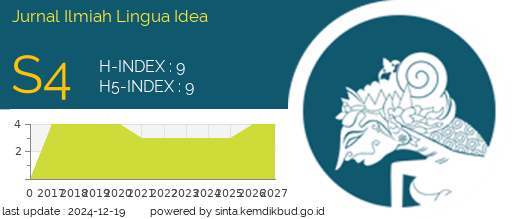Image of Ideal Housewife in Yoga Arizona's HappyFresh #BikinMertuaHappy Advertisement
Abstract
Advertisement has the potential to exploit female figures elaborated with particular signs or language that allude to gender bias in society to achieve commercial goals. One of the representations of women in advertisements shows the social position of women as subordinated figures in the domestic areas. This strategy is also applied in Yoga Arizona’s Happyfresh #BikinMertuaHappy advertisement posted on his Instagram account on July 25, 2020. This study examined the image of the ideal housewife as depicted in that advertisement. The research data include the visual and textual elements sourced from the video and caption in the advertisement. The depiction of the ideal housewife was analyzed using the Critical Discourse Analysis approach by Sara Mills (2003), examining the subject-object and writer-audience positions. This study has identified that the housewife plays double roles as the subject and the object in the advertisement, and the writer positions the audience as those who share common characteristics with the main character. This study has revealed that the ideal housewife depicted is the one that is capable, attentive, and reliable in taking care of the family to meet the mother-in-law’s standards. The positioning of women in the advertisement supports the gender imbalance in a domestic context.
References
Arizona, Yoga. (152 minggu yang lalu). #BikinMertuaHappy URL https://www.instagram.com/p/CDEG-lrnNcr/?igshid=MDJmNzVkMjY%3D
Bungin, B. (2013). Sosiologi komunikasi: Teori paradigma dan diskursus teknologi komunikasi di masyarakat.
Cook, G. (2001). The discourse of advertising (2nd ed). New York: Routledge.
Courtney, A. E. & Lockeretz, S. W. (2018). A woman’s place: An analysis of the roles portrayed by women in magazine advertisements. Journal of Marketing Research, 8(1).
Fahiratunnisa, Y. & Saragih, A. (2022). The Image of gender constructions in beverage brands advertisement. Linguistica, 11(2), 692–700.
Feramayasari, K., & Wiedarti, P. (2020). A Critical Discourse Analysis on Shopee 12.12 Birthday Sale Advertisement. Journal of English Language Teaching and Linguistics, 5(1), 121. https://doi.org/10.21462/jeltl.v5i1.393
Keraf, G. (2002). Diksi dan gaya bahasa. Jakarta: PT Gramedia Pustaka Utama.
Lane, W.R, King, K. W. & Reichert, T. (2011). Kleppner’s advertising procedure (18th ed). Upper Saddle River, NJ: Prentice-Hall.
Mills, S. (2003). Gender and Politeness. Cambridge: Cambridge University Press.
Nasiha, N. F., & Yunaldi, A. (2019). Representasi Kecantikan Dalam Iklan Slimmewhite (Studi Wacana Sara Mills). Al-MUNZIR, 12(1), 165. https://doi.org/10.31332/am.v12i1.1326
Rafiqa, S. (2019). Critical discourse analysis sara mils in the online news text about the sinking of ships at Indonesian waters. Hortatori, 3(1), 37-53.
Ramadhana, A. N. (2018). Analisis wacana kritis Sara Mills pada citra wanita dalam iklan televisi Axe parfum. Undergraduate Thesis. Universitas Muhammadiyah Sumatra Utara.
Rohmah, F. N., & Suhardi, S. (2020). Critical Discourse Analysis on TV Advertisements for Beauty Products. Indonesian Journal of EFL and Linguistics, 5(2), 453. https://doi.org/10.21462/ijefl.v5i2.316
Saraswati, T. (2018). Gender Representation and Cultural Value: The Comparison of Japanese and Indonesian Kit Kat Green Tea TV Commercials. 228(Klua), 234–243. https://doi.org/10.2991/klua-18.2018.34
Sari, D. P & Prasetio, A. (2020). Analisis wacana kritis Sara Mills pada iklan Purbasari Lulur Mandi Bengkoang+Whitening versi Double Whitening tahun 2016. e-Proceeding of Management, 7(1). 1659–1677.
Syafrini, D. (2014). Perempuan dalam jeratan eksploitasi media massa. Humanus: Jurnal Ilmiah Ilmu-Ilmu Humaniora, 13(1).
Wardhana, I.J.K. & Imron, A. (2015). Representasi produk teknologi rumah tangga dan spirit patriarki dalam iklan media massa DRTV. Paradigma, 3(1), 1-7.
Widyatama. (2007). Pengantar periklanan. Yogyakarta: Pustaka Book Publisher.
Yulianto, V. I. (2007). Pesona Barat: Analisa kritis-historis tentang kesadaran warna kulit Indonesia. Yogyakarta: Jala Sutra.

This work is licensed under a Creative Commons Attribution-ShareAlike 4.0 International License.
Authors who publish with Jurnal Ilmiah Lingua Idea agree to the following terms:
- Authors retain copyright and grant the journal right of first publication with the work simultaneously licensed under a Creative Commons Attribution License (CC BY-SA 4.0) that allows others to share the work with an acknowledgment of the work's authorship and initial publication in this journal.
- Authors are able to enter into separate, additional contractual arrangements for the non-exclusive distribution of the journal's published version of the work (e.g., post it to an institutional repository or publish it in a book), with an acknowledgment of its initial publication in this journal.
- Authors are permitted and encouraged to post their work online (e.g., in institutional repositories or on their website) prior to and during the submission process, as it can lead to productive exchanges, as well as earlier and greater citation of published work.





















.png)




_.png)


